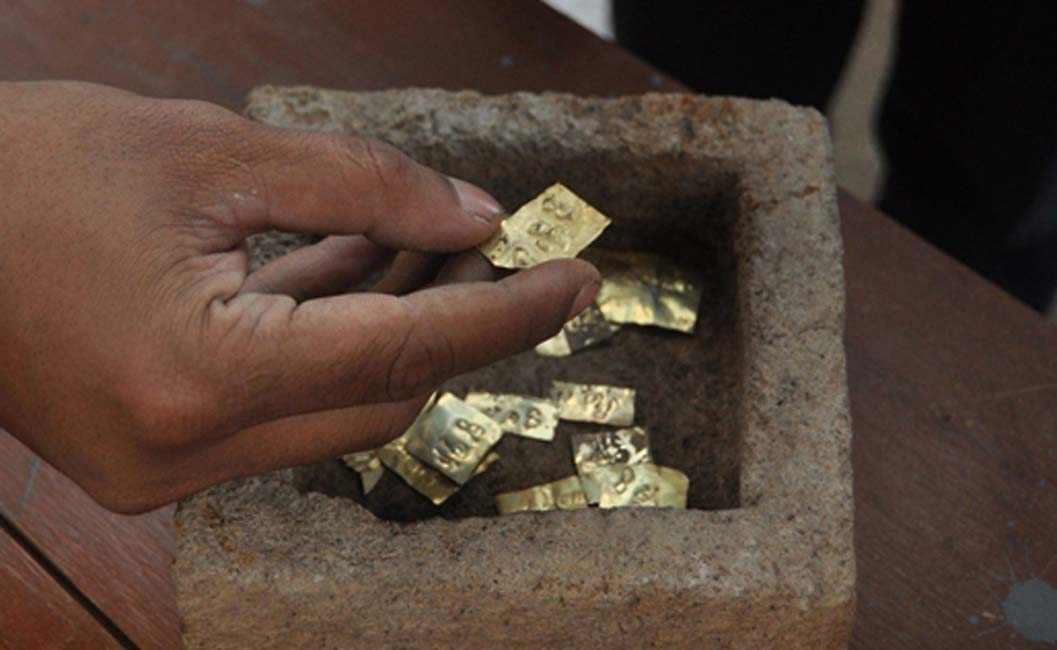22 Ancient Gold Plates Inscribed with Names of Gods Unearthed in Stone Box in Java
Twenty-two small gold plates with divine symbols and characters have been unearthed in central Java, a large island in the Indonesian archipelago. When archaeologists went to investigate, they found a candi (Buddhist or Hindu temple) in the same location as the stone box in which the gold plates were discovered.
Workers constructing a water aquifer project struck gold when they found the box with the gold plates that date to the 8 th century AD, says a story about the find on The Jakarta Post online.

An example of fine candi or temple on Java (Wikimedia Commons photo/Anandajoti)
The workers found the small gold plates in a pile of stones in Ringilarik village, Musuk district in the Boyolali area of Central Java, an island that is presently home to more than 100 million people.
The gold plates are 18 karat gold and are inscribed in ancient Javanese letters, Gutomo of the Central Java Heritage Conservation Agency told The Jarkarta Post.
The Post article says the inscriptions give the names of the cardinal and ordinal directions of the wind gods, called Dewa Lokapala, of the old Hindu-based religion of Java.
“We recorded eight names of wind Gods. We have also declared the location as a heritage site,” Gutomo told The Jarkarta Post.

A Buddhist stupa in India. Much smaller stupas have been found recently on the Indonesian island of Java. (Wikimedia Commons photo/Nandanupadhyay)
The owner of the land and the workers who discovered the gold plates will get some monetary compensation.
So far in 2016, people have made three big discoveries of ancient features in Boyolali, including another candi foundation that a brick maker found in April in the Giriroto village Ngemplak district. He found a Mahakala statue in the candi ruins.
Mahakala is a fierce, wrathful protector aspect of Buddhism’s Bodhisattva of Infinite Compassion, Avalokiteshvara. Mahakala is also identified in a story on IB Times as an avatar of Shiva, the great god of Hinduism.

Mahakala, seen here in a statue from Tibet, is described variously as an aspect of the Bodhisattva of Infinite Compassion and of Shiva. (Wikimedia Commons photo/Daderot)
Shiva is identified with another ancient god of India and Java, Rudra, who is associated with winds and storms, apparently like the Dewa Lokapala. It is said “Shiva” originated as an epithet of the earlier Rudra, who is known as “mightiest of the mighty.”
In the final age, the Indian gods Rudra and Vishnu will incarnate in one person as Kalkin-Rudra to save the world from the intensifying horrors of the final age.
Of Mahakala as Avalokiteshvara, the Web page Thranguhk.org states:
“This tutelary deity is one of the Dharmapalas in Vajrayana Buddhism who defend the Dharma from corruption and degeneration and from forces hostile to it; to keep the site of the ritual free from impure thoughts and actions; to guide and protect the individual practitioner from all kinds of deception and delusion; bestow the power to overcome life struggles; and to eliminate one’s obstacles and impediment that hinders.”
Experts estimated the statue dates to the ninth century, a period when Shiva Hinduism was ascendant in Java. Earlier at the same location, a Nandeswara statue was discovered.
In another village, Nepen, four stupas or dome-shaped Buddhist shrines about 1.5 meters (5 feet) tall, were discovered.
Featured image: Gold plates found in Java (Jakarta Post / Ganug Nugroho Adi)
By Mark Miller




















Comments
Christian and buddhist as well. Looking at the gold statue of Mahakala where you can see, as in the "Apocalypse" mentioned, "And the smoke of his burning goeth up forever, and they have no rest day, or night, etcetera, the fire is exactly the same as a halo, and the trampling and the skulls are the desire to cause the same condition, through initiation, in others, such that they too become aware of their preceding existences (the skulls- The Grateful Dead- Burning Man, The Whicker Man, etc) rather than remain lifeless without the Holy Ghost within them, 22 gold plates, one for each chapter of the Apocalypse of St John the Divine? Coincidence?
As for the Kalki myth, sorry, but that's just the Second Coming. The Apocalypse is a precis of the Ramayana, and other hindu mythologies which were transmitted through God's power to John on Patmos, possibly in the form of visions on and made with, the Clouds, Prophecy being a divinely inspired literary art form, not a real war, or the actual end of days, and written before TV and the Web stopped everyone from enjoying what is on offer if you are curious enough to demand proof of it in Person.....